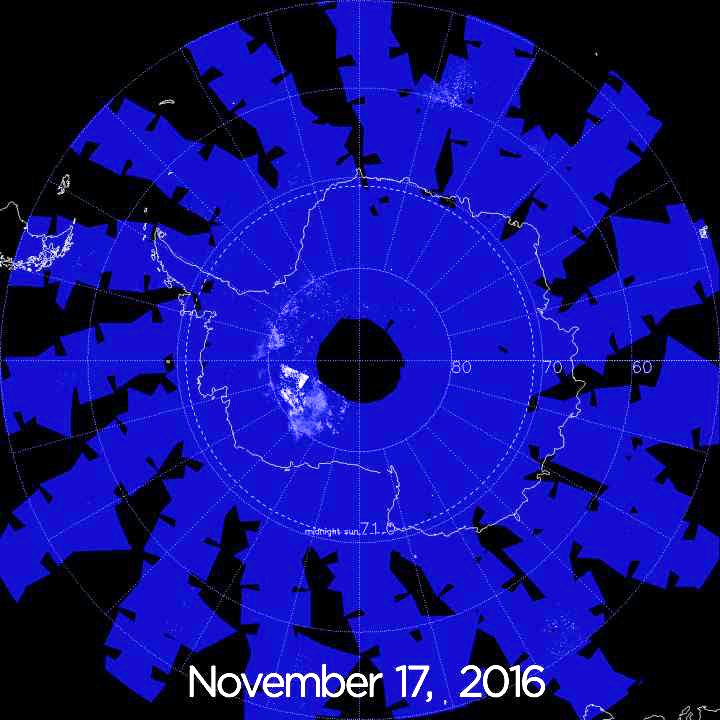NASA's AIM observes early noctilucent ice clouds over Antarctica

Data from NASA's Aeronomy of Ice in the Mesosphere, or AIM, spacecraft shows the sky over Antarctica is glowing electric blue due to the start of noctilucent, or night-shining, cloud season in the Southern Hemisphere. This data was collected from Nov. 17-28, 2016. Credit: NASA/HU/VT/CU-LASP/AIM/Joy Ng, producer
AIM studies noctilucent clouds in order to better understand the mesosphere, and its connections to other parts of the atmosphere, weather and climate. We observe them seasonally, during summer in both the Northern and Southern hemispheres.
This is when the mesosphere is most humid, with water vapor wafting up from lower altitudes. Additionally, this is also when the mesosphere is the coldest place on Earth – dropping as low as minus 210 degrees Fahrenheit – due to seasonal air flow patterns.
This year, AIM saw the start of noctilucent cloud season on Nov. 17, 2016 – tying with the earliest start yet in the AIM record of the Southern Hemisphere. Scientists say this corresponds to an earlier seasonal change at lower altitudes.
Winter to summer changes in the Antarctic lower atmosphere sparked a complex series of responses throughout the atmosphere – one of which is an earlier noctilucent cloud season. In the Southern Hemisphere, AIM has observed seasons beginning anywhere from Nov. 17 to Dec. 16.
Since its 2007 launch, AIM data has shown us that changes in one region of the atmosphere can effect responses in another distinct, and sometimes distant, region.
Scientists call these relationships atmospheric teleconnections. Now, due to natural precession, the spacecraft's orbit is evolving, allowing the measurement of atmospheric gravity waves that could be contributing to the teleconnections.
###
AIM is a NASA-funded mission managed by NASA's Goddard Space Flight Center in Greenbelt, Maryland, and led by the AIM principal investigator from the Center for Atmospheric Sciences at Hampton University in Hampton, Virginia.
Media Contact
All latest news from the category: Earth Sciences
Earth Sciences (also referred to as Geosciences), which deals with basic issues surrounding our planet, plays a vital role in the area of energy and raw materials supply.
Earth Sciences comprises subjects such as geology, geography, geological informatics, paleontology, mineralogy, petrography, crystallography, geophysics, geodesy, glaciology, cartography, photogrammetry, meteorology and seismology, early-warning systems, earthquake research and polar research.
Newest articles

A universal framework for spatial biology
SpatialData is a freely accessible tool to unify and integrate data from different omics technologies accounting for spatial information, which can provide holistic insights into health and disease. Biological processes…

How complex biological processes arise
A $20 million grant from the U.S. National Science Foundation (NSF) will support the establishment and operation of the National Synthesis Center for Emergence in the Molecular and Cellular Sciences (NCEMS) at…

Airborne single-photon lidar system achieves high-resolution 3D imaging
Compact, low-power system opens doors for photon-efficient drone and satellite-based environmental monitoring and mapping. Researchers have developed a compact and lightweight single-photon airborne lidar system that can acquire high-resolution 3D…





















